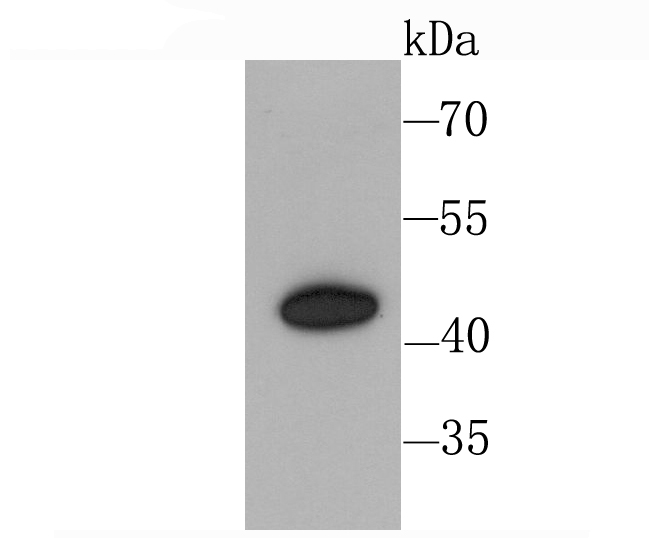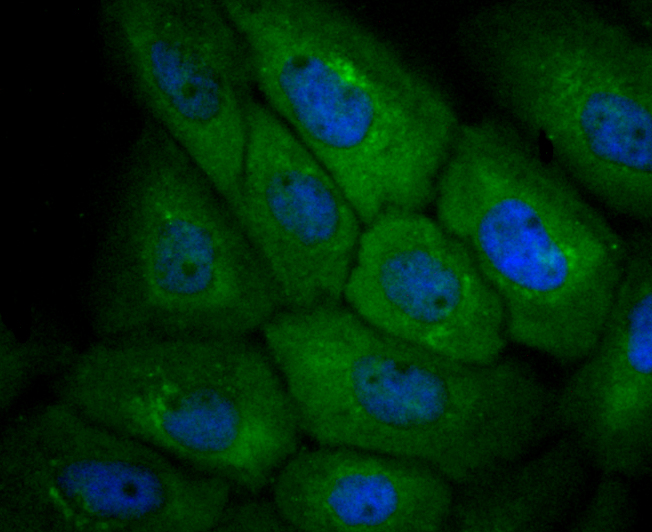Product Name :
CXCR3 polyclonal antibody Background :
The C-X-C or α chemokine family is characterized by a pair of cysteine residues separated by a single amino acid and primarily functions as chemoattractants for neutrophils. The C-X-C family includes IL-8, NAP-2, MSGA and stromal cell derived factor-1 (SDF-1). SDF-1 was originally described as a pre-B cell stimulatory factor, but has since been shown to function as a potent chemoattractant for T cells and monocytes but not neutrophils. Receptors for the C-X-C family are G protein-coupled, seven pass transmembrane domain proteins which include IL-8RA, IL-8RB, CXCR-3 and fusin (also designated LESTR or CXCR-4). CXCR-3, also known as IP-10/MIG receptor, mediates Ca2+ mobilization and chemotaxis in response to the C-X-C chemokines IP-10 and MIG. CXCR-3 is highly expressed in IL-2-activated T lymphocytes, but not in resting T lymphocytes, B lymphocytes, monocytes or granulocytes. Product :
Rabbit IgG, 1mg/ml in PBS with 0.02% sodium azide, 50% glycerol, pH7.2 Storage&Stability :
Store at +4°C after thawing. Aliquot store at -20°C or -80°C. Avoid repeated freeze / thaw cycles. Specificity :
CXCR3 polyclonal antibody detects endogenous levels of CXCR3 protein. Immunogen :
recombinant protein Conjugate :
Unconjugated Modification :
Unmodification
CXCR3 polyclonal antibody Background :
The C-X-C or α chemokine family is characterized by a pair of cysteine residues separated by a single amino acid and primarily functions as chemoattractants for neutrophils. The C-X-C family includes IL-8, NAP-2, MSGA and stromal cell derived factor-1 (SDF-1). SDF-1 was originally described as a pre-B cell stimulatory factor, but has since been shown to function as a potent chemoattractant for T cells and monocytes but not neutrophils. Receptors for the C-X-C family are G protein-coupled, seven pass transmembrane domain proteins which include IL-8RA, IL-8RB, CXCR-3 and fusin (also designated LESTR or CXCR-4). CXCR-3, also known as IP-10/MIG receptor, mediates Ca2+ mobilization and chemotaxis in response to the C-X-C chemokines IP-10 and MIG. CXCR-3 is highly expressed in IL-2-activated T lymphocytes, but not in resting T lymphocytes, B lymphocytes, monocytes or granulocytes. Product :
Rabbit IgG, 1mg/ml in PBS with 0.02% sodium azide, 50% glycerol, pH7.2 Storage&Stability :
Store at +4°C after thawing. Aliquot store at -20°C or -80°C. Avoid repeated freeze / thaw cycles. Specificity :
CXCR3 polyclonal antibody detects endogenous levels of CXCR3 protein. Immunogen :
recombinant protein Conjugate :
Unconjugated Modification :
Unmodification
-
 Western blot analysis of CXCR3 on Hela cell using anti-CXCR3 antibody at 1/1,000 dilution.
Western blot analysis of CXCR3 on Hela cell using anti-CXCR3 antibody at 1/1,000 dilution. -
 ICC staining CXCR3 in A431 cells (green). The nuclear counter stain is DAPI (blue). Cells were fixed in paraformaldehyde, permeabilised with 0.25% Triton X100/PBS.
ICC staining CXCR3 in A431 cells (green). The nuclear counter stain is DAPI (blue). Cells were fixed in paraformaldehyde, permeabilised with 0.25% Triton X100/PBS.
Bioworld Biotech only provide peptides for our antibodies and do not provide additional peptide customization services.
Price/Size :
USD 368/1mg/vial
Tips:
For phospho antibody, we provide phospho peptide(0.5mg) and non-phospho peptide(0.5mg).Describe :
Blocking peptides are peptides that bind specifically to the target antibody and block antibody binding. These peptide usually contains the epitope recognized by the antibody. Antibodies bound to the blocking peptide no longer bind to the epitope on the target protein. This mechanism is useful when non-specific binding is an issue, for example, in Western blotting (WB) and Immunohistochemistry (IHC). By comparing the staining from the blocked antibody versus the antibody alone, one can see which staining is specific; Specific binding will be absent from the western blot or IHC performed with the neutralized antibody.Formula:
Synthetic peptide was lyophilized with 100% acetonitrile and is supplied as a powder. Reconstitute with 0.1 ml DI water for a final concentration of 10 mg/ml.The purity is >90%,tested by HPLC and MS.
Storage:
The freeze-dried powder is more stable. For short time at 2-8°C. For long term storage store at -20°C.
Note :
This product is for research use only (RUO only). Not for use in diagnostic or therapeutic procedures.
 CXCR3 polyclonal antibody
CXCR3 polyclonal antibody  Datasheet
Datasheet COA
COA MSDS
MSDS SHIP
SHIP